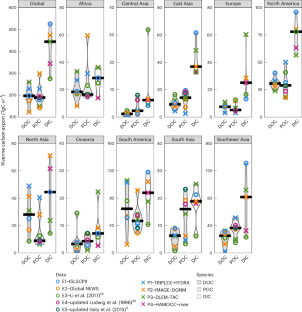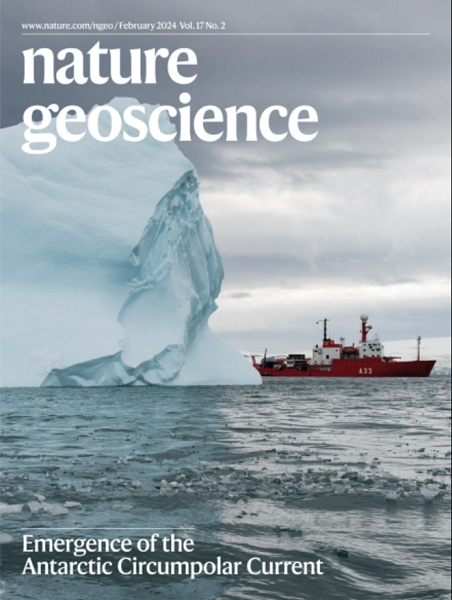Global riverine land-to-ocean carbon export constrained by observations and multi-model assessment
IF 16.1
1区 地球科学
Q1 GEOSCIENCES, MULTIDISCIPLINARY
引用次数: 0
Abstract
Rivers are a key component of the global carbon cycle. They receive vast quantities of terrestrial carbon, of which a large fraction is ultimately exported to the coastal ocean. Our review of previously published assessments reveals that substantial uncertainties remain with regard to the spatial distribution and speciation of the carbon export. Accurate quantification of the relative contributions of dissolved, particulate, organic and inorganic carbon to the total amounts is, however, of crucial importance for the coupling between the terrestrial and marine carbon cycles. Breaking down existing spatially explicit assessments over large river basins, we find a disagreement in flux estimates that exceeds two orders of magnitude for more than half of the basins. Using machine-learning techniques in combination with a multi-model ensemble and an updated database of observations, we overcome the inconsistencies in existing assessments and narrow down uncertainties in riverine carbon exports. Our revised assessment yields a global riverine export of 1.02 ± 0.22 (2σ) PgC yr−1. This carbon flux is partitioned into 0.52 ± 0.17, 0.30 ± 0.14, 0.18 ± 0.04 and 0.03 ± 0.02 PgC yr−1 of dissolved inorganic, dissolved organic, particulate organic and particulate inorganic carbon, respectively. We estimate the carbon contribution through groundwater export to be minor (0.016 PgC yr−1). Our assessment suggests an underestimation of the land-to-ocean carbon flux by 0.24 PgC yr−1 by the Intergovernmental Panel on Climate Change (IPCC) and calls for a revision of the oceanic carbon budget. Global riverine carbon export to the ocean may exceed previous estimates, underscoring the important role of riverine carbon to the carbon budget, according to a multi-model ensemble assessment constrained by a global dataset.


观测和多模型评估制约的全球河流陆地至海洋碳输出
河流是全球碳循环的重要组成部分。它们接收了大量的陆地碳,其中很大一部分最终被输出到沿岸海洋。我们对以前公布的评估结果进行了回顾,发现在碳输出的空间分布和种类方面仍然存在很大的不确定性。然而,准确量化溶解碳、颗粒碳、有机碳和无机碳对总量的相对贡献,对陆地碳循环和海洋碳循环之间的耦合至关重要。对现有的大河流域空间明确评估进行细分后,我们发现在一半以上的流域中,通量估计值的差异超过了两个数量级。利用机器学习技术,结合多模型集合和最新的观测数据库,我们克服了现有评估中的不一致性,缩小了河流碳输出的不确定性。我们修订后的评估得出全球河流碳输出量为 1.02 ± 0.22 (2σ) PgC yr-1。该碳通量分别为 0.52 ± 0.17、0.30 ± 0.14、0.18 ± 0.04 和 0.03 ± 0.02 PgC yr-1 的溶解无机碳、溶解有机碳、颗粒有机碳和颗粒无机碳。我们估计通过地下水输出的碳贡献很小(0.016 PgC yr-1)。我们的评估表明,政府间气候变化专门委员会(IPCC)低估了陆地到海洋的碳通量 0.24 PgC yr-1,并呼吁修订海洋碳预算。
本文章由计算机程序翻译,如有差异,请以英文原文为准。
求助全文
约1分钟内获得全文
求助全文
来源期刊

Nature Geoscience
地学-地球科学综合
CiteScore
26.70
自引率
1.60%
发文量
187
审稿时长
3.3 months
期刊介绍:
Nature Geoscience is a monthly interdisciplinary journal that gathers top-tier research spanning Earth Sciences and related fields.
The journal covers all geoscience disciplines, including fieldwork, modeling, and theoretical studies.
Topics include atmospheric science, biogeochemistry, climate science, geobiology, geochemistry, geoinformatics, remote sensing, geology, geomagnetism, paleomagnetism, geomorphology, geophysics, glaciology, hydrology, limnology, mineralogy, oceanography, paleontology, paleoclimatology, paleoceanography, petrology, planetary science, seismology, space physics, tectonics, and volcanology.
Nature Geoscience upholds its commitment to publishing significant, high-quality Earth Sciences research through fair, rapid, and rigorous peer review, overseen by a team of full-time professional editors.
 求助内容:
求助内容: 应助结果提醒方式:
应助结果提醒方式:


